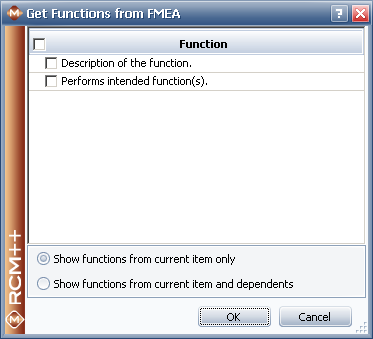

| Related Topics: | ||
Data in the DRBFM can be transferred to and from the associated FMEA. The following sections explain how functions in the FMEA can be transferred to the DRBFM, how data can be sent from the DRBFM to the associated FMEA and the relationships between the DRBFM columns and the FMEA hierarchy.
Please note that changes made in the FMEA do not appear automatically in the DRBFM and vice versa. The transfer functionality is intended to provide you with a starting point for the DRBFM by transferring function data from the FMEA. You can then make any necessary modifications and additions to the DRBFM. It also allows you to take the data that was entered into the DRBFM and use it in the FMEA.
You can send the FMEA header data to the DRBFM, and you can send the FMEA functions to the DRBFM.
Sending FMEA Header Data to the DRBFM
To send the FMEA header data to the DRBFM header, choose DRBFM > Synch > Get Header from FMEA. This makes the headers identical.
Sending FMEA Functions to the DRBFM
If you have an existing baseline FMEA, you can use the DRBFM to evaluate the risks that might be introduced by changes to the existing design, and you can use the FMEA functions that would be affected by the change as starting points for the DRBFM. Each function will be added as a new row in the worksheet. You have the choice to select functions from the FMEA for the current item only or from the FMEAs from the current item and all of its sub-items.
Note: If a function has associated records (i.e., failures, effects, causes, controls or actions) none of them will be transferred to the DRBFM.
To transfer the functions, do the following:
Choose DRBFM > Synch > Get Functions from FMEA. The Get Functions from FMEA window displays.

Do one of the following:
To show only the functions that belong to the current item, choose the Show functions from current item only option.
To show the functions that belong to the current item and its sub-items, choose the Show functions from current item and dependents option. Note that duplicate function names are not shown.
In the Functions area, select the functions that you want to transfer. Note that you can select all functions by selecting the check box in the Function header.
Click OK.
After you have analyzed the impact of the change, you can update the original FMEA with the new information from the DRBFM.
Sending DRBFM Header Data to the FMEA
To send the DRBFM header data to the FMEA header, choose DRBFM > Synch > Send Header to FMEA. This makes the headers identical.
Sending DRBFM Worksheet Data to the FMEA
When sending DRBFM data to the FMEA, note that the DRBFM data are appended to the existing FMEA data and do not overwrite the existing data. To transfer the data, do the following:
Choose DRBFM > Synch > Send Functions to FMEA. The Send Functions to FMEA window displays.

In the Functions area, select the functions that you want to transfer. Note that you can select all functions by selecting the check box in the Function header.
When sending DRBFM worksheet data to the FMEA worksheet, the following rules determine how and when data is transferred from the DRBFM worksheet to the FMEA worksheet:
The Part/Change to Design or Environment column will not be transferred. Data in this column is exclusive to the DRBFM.
The Function column will transfer as a function description.
The Concerns Related to Change and Other Concerns columns will transfer as failure descriptions.
The Potential Effects of Concern column will transfer as effect descriptions.
The Potential Cause of Concern and Other Causes columns will transfer as cause descriptions.
The Current Design Controls columns will transfer as control descriptions with the appropriate Control Type (i.e., detection or prevention). The Detection column will transfer to the first Control Type defined for the project and the Prevention column will transfer to the second Control Type. If there are two controls per row in the DRBFM worksheet, the associated User Defined field information will transfer to both controls in the FMEA. If the Control Type settings in your project differ, you can adjust them in the project’s interface style so that Detection is first and Prevention second.
The Recommended Action columns (i.e., Recommended Action - Design, Recommended Action - Validation/Test and Recommended Action - Manufacturing/Supplier) will transfer as action descriptions. The associated Responsibility columns will transfer to the "Display in Worksheet" field in the FMEA Action record. The associated Actions Taken column will transfer to the "Action Taken" field in the FMEA Action record. If there are multiple actions per row, the associated User Defined field information will transfer to each of those actions in the FMEA.
© 1992-2013. ReliaSoft Corporation. ALL RIGHTS RESERVED.